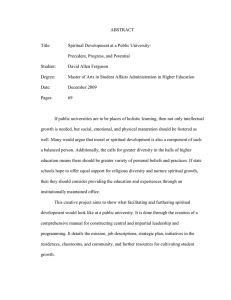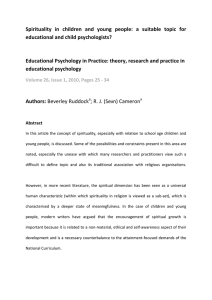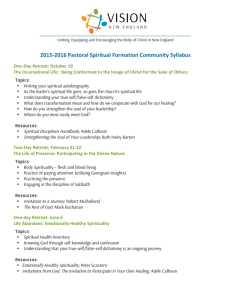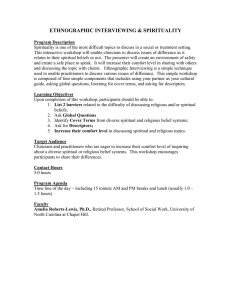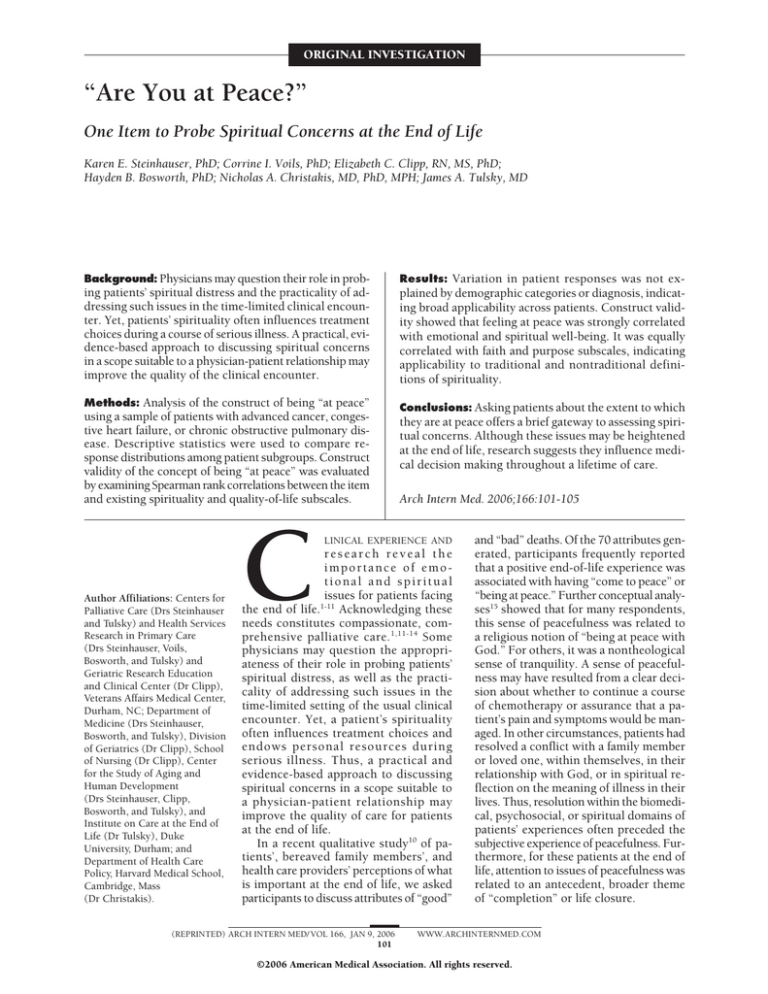
ORIGINAL INVESTIGATION
“Are You at Peace?”
One Item to Probe Spiritual Concerns at the End of Life
Karen E. Steinhauser, PhD; Corrine I. Voils, PhD; Elizabeth C. Clipp, RN, MS, PhD;
Hayden B. Bosworth, PhD; Nicholas A. Christakis, MD, PhD, MPH; James A. Tulsky, MD
Background: Physicians may question their role in probing patients’ spiritual distress and the practicality of addressing such issues in the time-limited clinical encounter. Yet, patients’ spirituality often influences treatment
choices during a course of serious illness. A practical, evidence-based approach to discussing spiritual concerns
in a scope suitable to a physician-patient relationship may
improve the quality of the clinical encounter.
Results: Variation in patient responses was not ex-
Methods: Analysis of the construct of being “at peace”
using a sample of patients with advanced cancer, congestive heart failure, or chronic obstructive pulmonary disease. Descriptive statistics were used to compare response distributions among patient subgroups. Construct
validity of the concept of being “at peace” was evaluated
by examining Spearman rank correlations between the item
and existing spirituality and quality-of-life subscales.
Conclusions: Asking patients about the extent to which
they are at peace offers a brief gateway to assessing spiritual concerns. Although these issues may be heightened
at the end of life, research suggests they influence medical decision making throughout a lifetime of care.
Author Affiliations: Centers for
Palliative Care (Drs Steinhauser
and Tulsky) and Health Services
Research in Primary Care
(Drs Steinhauser, Voils,
Bosworth, and Tulsky) and
Geriatric Research Education
and Clinical Center (Dr Clipp),
Veterans Affairs Medical Center,
Durham, NC; Department of
Medicine (Drs Steinhauser,
Bosworth, and Tulsky), Division
of Geriatrics (Dr Clipp), School
of Nursing (Dr Clipp), Center
for the Study of Aging and
Human Development
(Drs Steinhauser, Clipp,
Bosworth, and Tulsky), and
Institute on Care at the End of
Life (Dr Tulsky), Duke
University, Durham; and
Department of Health Care
Policy, Harvard Medical School,
Cambridge, Mass
(Dr Christakis).
C
plained by demographic categories or diagnosis, indicating broad applicability across patients. Construct validity showed that feeling at peace was strongly correlated
with emotional and spiritual well-being. It was equally
correlated with faith and purpose subscales, indicating
applicability to traditional and nontraditional definitions of spirituality.
Arch Intern Med. 2006;166:101-105
LINICAL EXPERIENCE AND
research reveal the
importance of emotional and spiritual
issues for patients facing
the end of life.1-11 Acknowledging these
needs constitutes compassionate, comprehensive palliative care. 1,11-14 Some
physicians may question the appropriateness of their role in probing patients’
spiritual distress, as well as the practicality of addressing such issues in the
time-limited setting of the usual clinical
encounter. Yet, a patient’s spirituality
often influences treatment choices and
endows personal resources during
serious illness. Thus, a practical and
evidence-based approach to discussing
spiritual concerns in a scope suitable to
a physician-patient relationship may
improve the quality of care for patients
at the end of life.
In a recent qualitative study10 of patients’, bereaved family members’, and
health care providers’ perceptions of what
is important at the end of life, we asked
participants to discuss attributes of “good”
(REPRINTED) ARCH INTERN MED/ VOL 166, JAN 9, 2006
101
and “bad” deaths. Of the 70 attributes generated, participants frequently reported
that a positive end-of-life experience was
associated with having “come to peace” or
“being at peace.” Further conceptual analyses15 showed that for many respondents,
this sense of peacefulness was related to
a religious notion of “being at peace with
God.” For others, it was a nontheological
sense of tranquility. A sense of peacefulness may have resulted from a clear decision about whether to continue a course
of chemotherapy or assurance that a patient’s pain and symptoms would be managed. In other circumstances, patients had
resolved a conflict with a family member
or loved one, within themselves, in their
relationship with God, or in spiritual reflection on the meaning of illness in their
lives. Thus, resolution within the biomedical, psychosocial, or spiritual domains of
patients’ experiences often preceded the
subjective experience of peacefulness. Furthermore, for these patients at the end of
life, attention to issues of peacefulness was
related to an antecedent, broader theme
of “completion” or life closure.
WWW.ARCHINTERNMED.COM
©2006 American Medical Association. All rights reserved.
To explore the statistical generalizability and breadth
of applicability of the concept of peacefulness among wider
groups, we translated qualitatively generated attributes
of what was important at the end of life into quantitative survey items and distributed them to nationally representative samples of bereaved family members and patients with advanced serious illness.14 Respondents were
asked to rate the extent to which they agreed with the
importance of items on a 5-point Likert scale. Eightynine percent of patients and 91.5% of families agreed with
the importance of “coming to peace with God.” Next, we
evaluated patients’ endorsements as a function of age, sex,
ethnicity, marital status, education, religious affiliation,
depressed mood, and self-rated health and found no statistically significant differences in endorsement across patient groups. In addition, we asked respondents to rankorder 9 prespecified attributes of the end-of-life
experience. Patients and families ranked as most important (and statistically equal to each other) “freedom from
pain” and “being at peace with God.” This reinforced the
equal footing of biomedical and emotional or spiritual
issues we had earlier observed for dying patients and their
families.10
Finally, in a subsequent sample of patients with advanced illness, we found that items measuring peacefulness correlated highly with having a chance to say goodbye; making a positive difference in the lives of others;
giving to others in time, gifts, or wisdom; having someone with whom to share their deepest thoughts; and having a sense of meaning in their lives.16 These correlations suggested that peacefulness was most strongly
associated with items assessing emotional and spiritual
well-being.
In reviewing these qualitative and quantitative data,
we were struck by the extent to which the concept of being
at peace applied to multiple contexts and with varied
meaning yet held a common, vital impact. Therefore, we
explored further the construct’s breadth of applicability
and conceptual significance. If widely accepted and conceptually sound, such a construct might serve as a brief,
nonthreatening gateway to eliciting patient and family
concerns.
The purpose of this study was to explore the construct of being at peace using quantitative data collected
from patients with advanced, life-limiting illness. Our goal
was to examine correlations with other assessments of
spirituality and quality of life to identify constructs associated with the experience of being at peace.
METHODS
This study used a cross-sectional sample of patients with advanced serious illness.16 The sample comprised patients with
stage IV cancer, congestive heart failure with an ejection fraction of 20% or less, chronic obstructive pulmonary disease with
a forced expiratory volume of 1.0 L or less, or dialysisdependent end-stage renal disease who were receiving care at
the Durham Veterans Affairs (VA) or Duke University Medical Centers, Durham, NC.17 To identify potential patients, we
reviewed weekly rosters from the oncology, heart failure, pulmonary, and dialysis clinics at both medical centers. We randomly assigned a recruitment order to all eligible patients and
(REPRINTED) ARCH INTERN MED/ VOL 166, JAN 9, 2006
102
enrolled as many as time allowed for each clinic half-day. Written informed consent was obtained at the time of recruitment.
We administered the Short Portable Mental Health Status Questionnaire (SPMSQ) at enrollment and excluded patients with
scores lower than 8 of 10 correct.18 A total of 248 patients were
enrolled.
ITEM DEVELOPMENT
In the national survey, Factors Considered Important at the End
of Life,14 the item wording was “coming to peace with God.”
However, qualitative work has shown that peace is associated
with relationships with others and oneself as well as with God.
For some individuals, these were overlapping interpretations;
for others, they were distinct. We were curious about whether
these interpretations were performed distinctly, psychometrically. Therefore, in a subsequent study16 (data not reported
herein), we examined distributions of several religious and nonreligious alternative wordings: “at peace with God,” “at peace
in my personal relationships,” “at peace with myself.” Both correlations with other items and within-item distributions were
not significantly different; therefore, to promote inclusiveness, the final item employed wording in which respondents
answered a question about the extent to which they were “at
peace.”
COMPARISON MEASURES
Patients completed several instruments to assess quality of life
at the end of life as well as social support. First, they completed
the QUAL-E, a 31-item assessment of quality of life at the end of
life representing 4 domains: life completion, relationship with
health care provider, symptom impact, and preparation for the
end of life.16 The instrument exhibits strong validity and reliability and is acceptable to seriously ill patients. Within the
QUAL-E, 1 item asks patients about the extent to which they are
“at peace.” Second, patients completed the Functional Assessment of Chronic Illness Therapy–Spiritual (FACIT-SP), a 27item, 5-domain, expanded version of the Functional Assessment of Cancer Therapy–General (FACT-G) quality-of-life scale
with a 12-item spiritual well-being subscale.19 The other 4 subscales are physical well-being, functional well-being, social and
family well-being, and emotional well-being.20 It was not designed specifically for use with terminally ill patients but remains a broadly used, well-validated, and reliable general qualityof-life assessment tool. The spirituality well-being subscale
contains 2 dimensions, faith and purpose, and has been validated for patients with cancer and human immunodeficiency virus. Questions focus on 2 dimensions: the extent to which patients feel a sense of meaning and purpose in their life and the
extent to which they find comfort or strength in their faith and
spirituality. Finally, patients completed the 13-item social support subscale from the Duke University Established Population
for Epidemiologic Studies of the Elderly (EPESE) survey, which
includes instrumental and affective support subscales.
STATISTICAL ANALYSIS
We conducted correlational analyses to examine the relationship between the extent to which patients felt “at peace” and demographic categories, diagnoses, and site of recruitment. To explore construct validity, we examined Spearman rank correlations
between patients’ assessments of the extent to which they were
“at peace” and the FACIT-SP and EPESE subscales. Statistical
analyses were performed with SAS software (version 8; SAS Institute, Cary, NC). The institutional review boards of the VA and
Duke University Medical Centers approved both studies.
WWW.ARCHINTERNMED.COM
©2006 American Medical Association. All rights reserved.
RESULTS
Table. Sample Profile of 248 Patients
A total of 320 potential subjects were approached; 53 refused to participate, and 19 demonstrated significant cognitive impairment, yielding a response rate of 78%. We
enrolled 100 patients from the VA and 148 from the Duke
University Medical Centers. All 248 patients completed
the interview. Twenty-two did not report any symptoms; compared with the full sample of 248 subjects, they
were more likely to be female (50%), slightly older (mean
age, 64 years), and not married (55%), and a higher percentage (27%) had congestive heart failure.
Participants had at least 1 of 4 life-threatening conditions: stage IV cancer (56%), congestive heart failure
(21%), end-stage renal disease (14%), and chronic obstructive pulmonary disease (8%). Approximately 59%
of subjects were male; 59%, white; and 34%, black. The
sample showed a broad educational distribution, and a
majority (62%) were married. The median age of patients was 61 years (range, 28-88 years) (Table).
First, we examined the relationship between the extent to which patients felt “at peace” and demographic categories. We found no significant relationships with ethnicity, education, sex, diagnosis, site of recruitment, or
marital status. We observed a small but positive correlation between age and feeling at peace (r=0.24). Thus, in 2
samples,14,16 with the exception of age, the notion of being
“at peace” was not explained by demographic variables.
After testing the breadth of applicability of the concept of being at peace, we conducted correlational analyses to examine its conceptual underpinnings. Our goal was
to understand what elements of patient experience this
single item may be tapping. Therefore, we analyzed associations between being at peace and existing subscales,
namely, the FACIT quality of life subscales: emotional, social, physical, functional, and spiritual well-being. We also
examined its association with both instrumental and affective social support given by patients.
Analyses showed that peacefulness was most strongly
associated with the emotional and spiritual well-being
subscales (r =0.52 and 0.60, respectively). We observed
small and moderately significant relationships with other
dimensions of quality of life: physical well-being (r=0.28),
functional well-being (r = 0.35), and social well-being
(r=0.41). We did not observe significant associations with
either instrumental or affective support given by patients (r=0.06 and −0.08, respectively).
To explore the relationship between the indicator of
peacefulness and spirituality more specifically, we assessed correlations between peacefulness and the 2 dimensions within the FACIT spirituality subscale: faith
and purpose. We found significant associations between feeling at peace and both dimensions (purpose:
r=0.47, P⬍.001; faith: r=0.51, P⬍.001), suggesting similar construct resonance for the religious as well as meaning-making components of spirituality.
COMMENT
Dying patients confront complex spiritual concerns that
influence the course of their illness, treatments chosen,
(REPRINTED) ARCH INTERN MED/ VOL 166, JAN 9, 2006
103
Variable
Sex
Men
Women
Ethnicity
Black
White
Native American
Other
Education*
⬍High school
High school diploma
Associate’s degree
Bachelor’s degree
Graduate/professional degree
Marital status*
Married/living with partner
Widowed
Divorced/separated
Never married
Diagnosis*
Cancer
COPD
CHF
ESRD
Recruitment Site
VAMC
DUMC
Age, y
Percentage
59
41
34
59
2
5
13
44
23
13
8
62
8
23
8
56
8
21
15
40
60
Median, 61; range, 28-88
Abbreviations: CHF, congestive heart failure; COPD, chronic obstructive
pulmonary disease; DUMC, Duke University Medical Center; ESRD,
end-stage renal disease; VAMC, Veterans Affairs Medical Center.
*Does not equal 100% due to rounding.
relationships with loved ones, and overall quality of life.
Despite the importance of spiritual issues during serious illness, these fundamental issues may not be readily
elicited in a usual clinical encounter. Furthermore, clinicians may struggle to initiate such a discussion in a nonthreatening, inclusive manner, particularly when patients’ religious affiliations and preferences may differ from
physicians’ or are unknown.1,11-13,21-23
The literature shows variation in patient preferences for
discussing religious and spiritual issues with their physicians. In one survey24 of hospital inpatients, 77% said their
physicians should consider their spiritual needs, 37%
wanted their physician to discuss religious beliefs with them,
48% wanted their physicians to pray with them, and 68%
said their physician had never discussed religious beliefs
with them. Other studies24-26 from outpatient settings reported lower percentages of patients who welcomed such
questions (21%-40%). In a subsequent study of outpatient pulmonary clinic patients, Ehman and colleagues11
showed that 94% believed that if patients were gravely ill,
their physicians should ask if they “had religious or spiritual beliefs that would influence their medical decisions.”
These authors hypothesize that variation in endorsement
may be associated with different wording of questions. For
example, they suggest that direct open-ended questions such
as “What are your religious or spiritual beliefs?” may evoke
mistrust about the personal boundaries of such a converWWW.ARCHINTERNMED.COM
©2006 American Medical Association. All rights reserved.
sation or cause patients to question physicians’ motivation. To summarize, research suggests that religious and
spiritual concerns are important to many patients and influence their decision making, yet patients may feel awkward entering conversations about spiritual matters. Such
conversations may be perceived variably among patient subpopulations.
The results of this study suggest that the concept of
patients’ sense of being at peace may be a point with which
to initiate a conversation about emotional and spiritual
concerns in a nonthreatening, nonsectarian manner. Data
from the national survey reported by Steinhauser et al14
show broad endorsement for this item’s importance from
patients and family members. Variation in the strength
of their agreement was not explained by demographic categories, diagnosis, mood, or self-reported health, which
suggests that use of the construct is applicable to patients with varied backgrounds and illness courses.
Our tests of distributions and subsample differences
according to varied wording (ie, “at peace with God,” “at
peace with my personal relationships,” and “at peace with
myself”) revealed broad applicability of concepts or an
intertwining of concepts into a whole, more general notion of peacefulness. Our subsequent use of the concept
was worded generally as feeling “at peace.” When assessing associations with the extent to which patients were
“at peace,” demographic categories other than age exhibited no explanatory power. It is not surprising that
younger patients (⬍50 years) with advanced serious illness report lower levels of peacefulness. Again, these
analyses showed applicability of the concept of being “at
peace” across patient subgroups.
Spirituality has been defined as the search for or attention to the ultimate meaning and purpose in life, often involving a relationship with the transcendent.27 That
relationship may be expressed in the context of human
interactions or in terms of belief in a higher being.27 Construct analyses revealed emotional and spiritual wellbeing underpinnings of the broadly worded construct of
being at peace. Subanalyses involving comparisons of the
item with the FACIT spirituality subscale showed equal
strength of association for both faith and purpose dimensions, suggesting that the concept may be useful to
patients who discuss spirituality in more or less traditionally religious terms. Clinicians may note the frame
of reference most suitable to particular patients. However, a reference to being at peace may cue patients to
discussions about and beyond spiritual issues.
The purpose of these analyses is not to reduce spiritual, religious, or emotional concerns to a construct of peace,
nor does use of the item constitute a full spiritual history.
Rather, we liken its use to the single question, “Are you
depressed?”, which works well as a screening tool that indicates when there is a need for a fuller psychological assessment.28 These data indicate use of the concept of peacefulness as a gateway to larger discussions, framed according
to patients’ values, preferences, and life experiences.
The specific language patients choose to use in response to the question “Are you at peace?” reveals their
frame of reference, dimensions of distress, and acceptable terminology for discourse. If a patient’s response connotes a spiritual frame, physicians may continue with a
(REPRINTED) ARCH INTERN MED/ VOL 166, JAN 9, 2006
104
more in-depth spiritual assessment in which he or she asks
more specifically about what role faith or spirituality plays
in the life of the patient and in the role of health and decision making. Furthermore, the physician may inquire
about the role of a faith community as support and about
how the patient would like his or her spiritual needs to
be addressed in the health care context.27,29,30 Alternatively, if patients respond to questions of peacefulness using an affective frame of reference, the physician may probe
mood and emotional well-being. Although clinicians and
researchers may divide patients’ emotional and spiritual
concerns into separate domains, previous studies10,31 suggest that patients and families initially experience these concerns as a part of a larger whole of suffering or disruption. The construct presented in this article, as shown in
the following 2 examples of dialogue, is offered as a bridge
to those concerns.
Physician: We’ve talked a lot about the decisions you’re making from a medical perspective. I’m wondering whether you feel
at peace with those decisions.
Patient: Well, I wish I didn’t have cancer and didn’t have to
make these choices in the first place.
Physician: I wish that too . . .
Patient: But, given that I am where I am, I think I’ve made the
best choices I can.
Physician: How have you been doing?
Patient: Okay, I guess.
Physician: I’m wondering how you’re doing living with your
illness. I sometimes hear people talk about whether or not they’re
at peace. Do you feel that you are at peace in your life right
now?
Patient: Well, when you ask it that way, no.
Physician: Tell me more.
Patient: I just can’t seem to get a handle on all this . . .
In his presentation of a bio-psychosocial-spiritual
model for care of patients at the end of life, Sulmasy32
offers a framework of “right relationships” as building
blocks of physical, psychological, social, and spiritual wellbeing. Patients’ end-of-life experiences are constructed
by multidimensional layers of relationships of physiological and biochemical processes, cognitive understandings, interpersonal connections, and bonds to the
transcendent. Suffering is associated with relationship disruption or conflict. Asking patients about the extent to
which they are at peace may initiate discussions that reveal suffering in any of the 4 dimensions.
However, clinicians may fear, often appropriately, that
theological discussions rest outside the purview of their
role or expertise. Using inquiries about the extent to which
a patient or family members are at peace (with choices
and decisions, for example) offers a straightforward approach to exploring spiritual concerns. Physicians and
other health care providers may then refer patients and
their families to specialized care professionals, such as
chaplains, while appreciating the kinds of distress with
which patients struggle as they traverse the course of serious illness. Physicians seeking more extended assessment tools for research purposes may explore recently
developed spirituality scales.33,34
This study has several limitations. Most of the 100 patients recruited from the VA Medical Center were male.
However, we oversampled women at Duke University
WWW.ARCHINTERNMED.COM
©2006 American Medical Association. All rights reserved.
Medical Center to permit sufficient statistical power to
detect differences between men and women. Patients were
predominantly white and black. Patients at the VA Medical Center resided predominantly in 1 geographic region. However, Duke University Medical Center draws
from both regional and national patient pools.
Although this study’s samples included patients with
advanced serious illness, the construct of being “at peace,”
or peacefulness, and the discussions and communication techniques described may be applicable to patients
and families at many stages of health and illness. Although a patient at the end of life has a heightened awareness of the importance of nonbiomedical dimensions, research suggests spiritual concerns affect a patient’s choices
throughout a lifetime of care.
Accepted for Publication: June 26, 2005.
Correspondence: Karen E. Steinhauser, PhD, VA and
Duke Medical Centers, Hock Plaza, Suite 1105, Box 2720,
2424 Erwin Rd, Durham, NC 27705 (karen.steinhauser
@duke.edu).
Financial Disclosure: None.
Funding/Support: This study was based on work supported by the Office of Research and Development Health
Services Research and Development Service, Department of Veterans Affairs (IIR No. 98-162), and the Duke
Institute on Care at the End of Life. Dr Steinhauser is supported by a VA Career Development Award.
Role of the Sponsor: Funders provided general support
for the projects but did not have any role with regard to
design or conduct of the study; collection, management, analysis, or interpretation of the data; or preparation, review, or approval of the manuscript.
Disclaimer: The views expressed in this article are those
of the authors and do not necessarily represent the views
of the Department of Veterans Affairs or Duke University.
REFERENCES
1. Post SG, Puchalski CM, Larson DB. Physicians and patient spirituality: professional boundaries, competency, and ethics. Ann Intern Med. 2000;132:
578-583.
2. Yawar A. Spirituality in medicine: what is to be done? J R Soc Med. 2001;94:
529-533.
3. Daaleman TP, Kuckelman Cobb A, Frey BB. Spirituality and well-being: an exploratory study of the patient perspective. Soc Sci Med. 2001;53:1503-1511.
4. Koenig HG. Religion, spirituality, and medicine: how are they related and what
does it mean? Mayo Clin Proc. 2001;76:1189-1191.
5. Mueller PS, Plevak DJ, Rummans TA. Religious involvement, spirituality, and
medicine: implications for clinical practice. Mayo Clin Proc. 2001;76:
1225-1235.
6. Lyon ME, Townsend-Akpan C, Thompson A. Spirituality and end-of-life care for
an adolescent with AIDS. AIDS Patient Care STDS. 2001;15:555-560.
7. Sloan RP, Bagiella E, Powell T. Religion, spirituality, and medicine. Lancet. 1999;
353:664-667.
(REPRINTED) ARCH INTERN MED/ VOL 166, JAN 9, 2006
105
8. Levin JS, Larson DB, Puchalski CM. Religion and spirituality in medicine: research and education. JAMA. 1997;278:792-793.
9. Sloan RP, Bagiella E. Spirituality and medical practice: a look at the evidence.
Am Fam Physician. 2001;63:33-34.
10. Steinhauser KE, Clipp EC, McNeilly M, Christakis NA, McIntyre LM, Tulsky JA.
In search of a good death: observations of patients, families, and providers. Ann
Intern Med. 2000;132:825-832.
11. Ehman J, Ott B, Short T, Ciampa R, Hansen-Flaschen J. Do patients want physicians to inquire about their spiritual or religious beliefs if they become gravely
ill? Arch Intern Med. 1999;159:1803-1806.
12. Lo B, Ruston D, Kates LW, et al. Discussing religious and spiritual issues at the
end of life: a practical guide for physicians. JAMA. 2002;287:749-754.
13. Lo B, Kates LW, Ruston D, et al. Responding to requests regarding prayer and
religious ceremonies by patients near the end of life and their families. J Palliat
Med. 2003;6:409-415.
14. Steinhauser KE, Christakis NA, Clipp EC, McNeilly M, McIntyre L, Tulsky JA.
Factors considered important at the end of life by patients, family, physicians,
and other care providers. JAMA. 2000;284:2476-2482.
15. Roberts KT, Aspy CB. Development of the serenity scale. J Nurs Meas. 1993;1:
145-164.
16. Steinhauser KE, Bosworth HB, Clipp EC, et al. Initial assessment of a new instrument to measure quality of life at the end of life. J Palliat Med. 2002;5:
829-841.
17. Steinhauser KE, Clipp EC, Bosworth HB, et al. Measuring quality of life at the
end of life: validating the QUAL-E. Palliative Supportive Care. 2004;2:3-14.
18. Pfeiffer E. A short portable mental status questionnaire for the assessment of
organic brain deficit in elderly patients. J Am Geriatr Soc. 1975;23:433-441.
19. Brady MJ, Cella D. Assessing quality of life in palliative care. Cancer Treat Res.
1999;100:203-216.
20. Cella DF, Tulsky DS, Gray G, et al. The Functional Assessment of Cancer Therapy
scale: development and validation of the general measure. J Clin Oncol. 1993;
11:570-579.
21. Koenig HG, Bearon LB, Dayringer R. Physician perspectives on the role of religion in the physician-older patient relationship. J Fam Pract. 1989;28:
441-448.
22. Cohen CB, Wheeler SE, Scott DA, Edwards BS, Lusk P. Prayer as therapy: a challenge to both religious belief and professional ethics: the Anglican Working Group
in Bioethics. Hastings Cent Rep. 2000;30:40-47.
23. Cohen CB, Wheeler SE, Scott DA. Walking a fine line: physician inquiries into
patients’ religious and spiritual beliefs. Hastings Cent Rep. 2001;31:29-39.
24. King D, Bushwick B. Beliefs and attitudes of hospital inpatients about faith healing and prayer. J Fam Pract. 1994;39:349-352.
25. Maugans TA, Wadland WC. Religion and family medicine: a survey of physicians and patients. J Fam Pract. 1991;32:210-213.
26. Daaleman TP, Nease DE Jr. Patient attitudes regarding physician inquiry into spiritual and religious issues. J Fam Pract. 1994;39:564-568.
27. Puchalski C, Romer AL. Taking a spiritual history allows clinicians to understand patients more fully. J Palliat Med. 2000;3:129-137.
28. Chochinov HM, Wilson KG, Enns M, Lander S. “Are you depressed?”: screening
for depression in the terminally ill. Am J Psychiatry. 1997;154:674-676.
29. Puchalski C. Spiritual assessment tool. J Palliat Med. 2000;3:131.
30. Koenig HG. Taking a spiritual history [Student JAMA ]. JAMA. 2004;291:2881.
31. Steinhauser KE, Christakis NA, Clipp EC, et al. Preparing for the end of life: preferences of patients, families, physicians, and other care providers. J Pain Symptom Manage. 2001;22:727-737.
32. Sulmasy DP. A biopsychosocial-spiritual model for the care of patients at the
end of life. Gerontologist. 2002;42(special issue):24-33.
33. Underwood LG, Teresi JA. The Daily Spiritual Experience Scale: development,
theoretical description, reliability, exploratory factor analysis, and preliminary construct validity using health-related data. Ann Behav Med. 2002;24:22-33.
34. Hays JC, Meador KG, Branch PS, George LK. The Spiritual History Scale in four
dimensions (SHS-4): validity and reliability. Gerontologist. 2001;41:239-249.
WWW.ARCHINTERNMED.COM
©2006 American Medical Association. All rights reserved.



